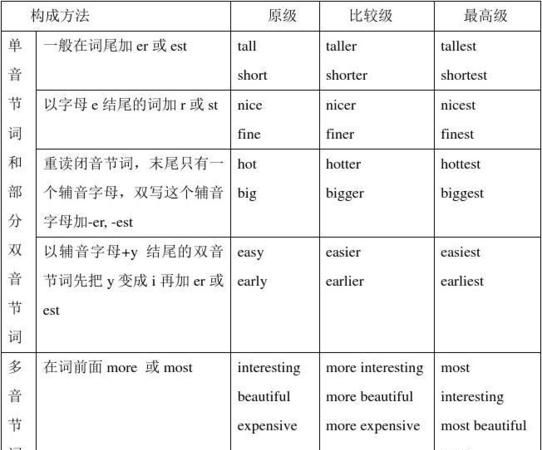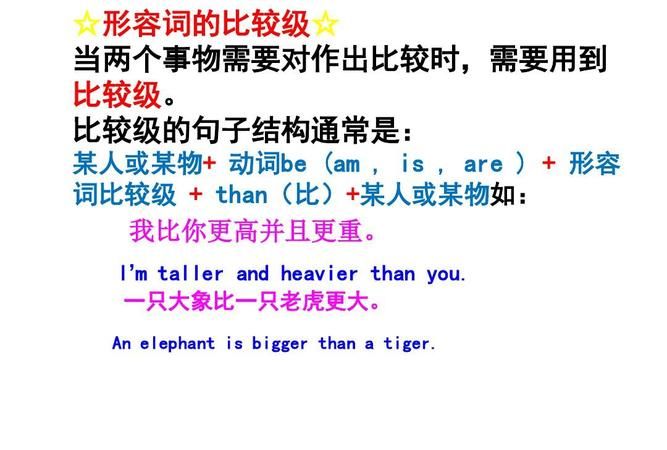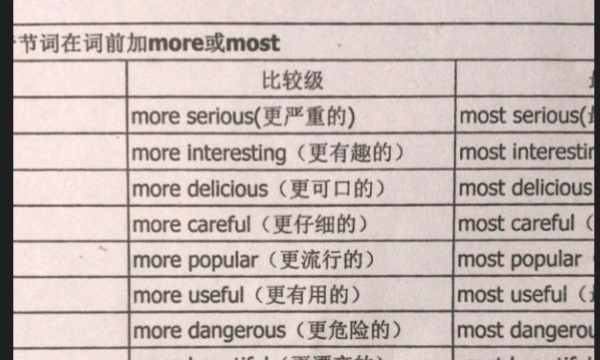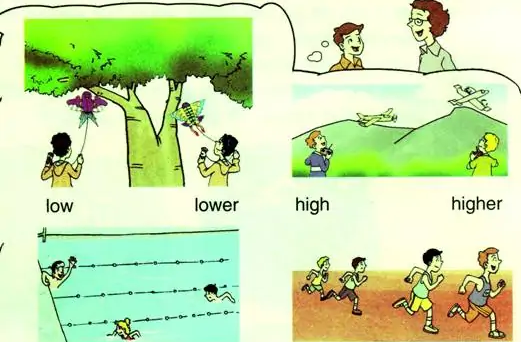本文目录
形容词比较级的变化规则
形容词变比较级的变化规则:
1、单音节形容词和部分双音节词,一般在词尾加-er;
2、以字母e结尾的词,在词尾直接加-r,如:nice-nicer、fine-finer、wide-wider、close-closer、large-larger等。
扩展资料
3、重读闭音节词词尾只有一个辅音字母,元音发短音时,双写尾字母,再加er;
4、以"辅音字母+y“结尾的'双音节词,变”y“为”i“,再加-er;
5、多音节词和部分双音节词,在词前加”more“;
6、部分形容词和副词的比较级是不规则的,如:good/well-better,bad/badly-worse;
7、由“动词+后缀-ing/-ed”构成的形容词,在词前加more构成比较级。如:interesting-more interesting,bored-more bored;
8、由“形容词+后缀-ly”构成的副词,在该副词前加more构成比较级。如:slowly-more slowly。

形容词比较级的构成规则
cleverer cleverest more___ most___ 也行
形容词比较级、最高级的构成
一、 规则变化
1. 单音节词和少数双音节词
(1)一般情况在原级词尾加-er构成比较级,加-est构成最高级。如:high→higher→highest。
(2)以e结尾的词,直接加-r 或-st。如:large→larger→largest。
(3)重读闭音节,末尾只有一个元音字母加一个辅音字母的词,先双写这一辅音字母再加-er或 -est。如:big→bigger→biggest。
(4)以“辅音字母 + y”结尾的词,先变 “y”为 “i”,再加-er 或-est。如:happy→happier→happiest。
2. 大部分双音节词和所有多音节词
在原级前加more构成比较级,加most构成最高级。如:dangerous→more dangerous→the most dangerous。
二、 不规则变化
有一些词的比较级、最高级变化是不规则的,需要特殊记忆。如:
good / well→better→best
bad / ill→worse→worst
many / much→more→most
little→less→least
far→farther→farthest(表示距离) / far→further→furthest (表示程度)
old→older / elder→oldest (表示新旧或年龄) / eldest (表示兄弟姐妹之间的长幼关系)
三、 一些词的比较级和最高级,可以加-er或 -est,也可以加more或most,如:clever, polite等。
四、一些词本身没有比较级和最高级形式,如:right, wrong, full, empty, round, complete, wooden, dead, daily等。
形容词比较级的用法
1. 两者比较时用形容词比较级,其结构为“... 比较级 + than ...”。如:Actions speak louder than words.
2. 在两者之间选择“哪一个更……”时,用句型 “Which / Who is +比较级, ... or ...?”。 如:Which sweater is cheaper, the red one or the yellow one?
3. 表示“两者之间最……的一个”时,用“the + 比较级”。如:Lucy is the taller of the twins.
4. 表示“越……,越……”时,用“the + 比较级,the + 比较级”。如:The more you eat, the fatter you will become.
5. 表示“越来越……”时,用“比较级 + and + 比较级”,多音节词和部分双音节词用“more and more + 形容词原级”。如:We should make our country more and more beautiful.
6. 形容词比较级前可以用下列词修饰:much, a little, far, a bit, a few, a lot, even, still, rather等。如:It's much colder today than yesterday.
形容词最高级的用法
1. 三者或三者以上的人或物进行比较时,用形容词最高级形式。形容词最高级前通常需加定冠词the,句末常接in / of短语来表示范围。如:He is the strongest of all the boys.
2. 表示“最……之一”时,用 “one of + the + 最高级”。如:The light bulb is one of the most helpful inventions.
3. 形容词最高级前可以由物主代词、指示代词、名词所有格等修饰,此时不用定冠词the。如:Yesterday is her happiest day in her life.

形容词的比较级是什么意思
比较等级有三级:原级、比较级和最高级,其构成规则主要如下:
1、单音节形容词:比较级=原级+er;最高级=原级+est。例如:
kind—kinder—kindest。
long—longer—longest。
注:
(1)若原级以字母e结尾,则只加-r和-st。例如:large—larger—largest。
(2)若原级以“辅音字母+y”结尾,则将y改为i,再加-er和-est。例如:dry—drier—driest。
(3)若原级为重读闭音节结尾,且末尾只有一个辅音字母,则双写这个辅音字母后再加-er和-es。例如:big—bigger—biggest。
2、三音节或多于三音节的形容词:比较级=more+原级;最高级=most+原级。例如:
beautiful—more beautiful—most beautiful。
complicated—more complicated—most complicated。

3、以-y和-ow结尾的双音节形容词:比较级=原级+er;最高级=原级+est。例如:
happy—happier—happiest。
shallow—shallower—shallowest。
4、其他双音节形容词:两种形式均适用。例如:
tender—tenderer/more tender—tenderest/most tender。
clever—cleverer/more clever—cleverest/most clever。
5、不规则形式:有少数形容词的比较级和最高级是不规则的。例如:
good—better—best。
bad—worse—worst。
little—less—least。
many/much—more—most。
old—older/elder—oldest/eldest。
far—farther/further—farthest/furthest。
形容词比较级和最高级的变化规则口诀
形容词比较级的变化规则口诀如下:
1、一般在词尾直接加er或est,例如,tall-taller-tallest,long-longer-longest。
2、以不发音的字母e结尾的单词在词尾直接加r或st,例如,nice-nicer-nicest。
3、以辅音字母+y结尾的词,把y变为i,再加er或est,例如,heavy-heavier-heaviest。

4、重读闭音节,末尾只有一个辅音字母,双写这个辅音字母,再加er或est,例如,big-bigger-biggest。
5、部分双音节词和多音节词分别在原级前加more构成比较级和most构成最高级,例如,slowly-moreslowly-mostslowly;beautiful-morebeautiful-mostbeautiful。
以上就是关于形容词比较级的构成规则 ,形容词比较级的变化规则的全部内容,以及形容词比较级的构成规则 的相关内容,希望能够帮到您。

